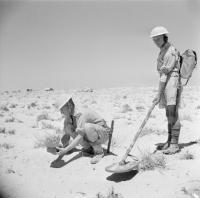Józef Kosacki – an engineer at the fronts of WWII
Kosacki started his studies at the Faculty of Electrical Engineering of the Warsaw University of Technology in 1928 to obtain the degree of an electrical engineer five years later. However, the biggest challenge of his lifetime was still ahead. His mine detector was a significant contribution to the Allied victory in WWII.
He did military training right after studies. Before WWII, he worked for the Polish Institute of Telecommunications. As early as at the beginning of the invasion of Poland, on 4 September 1939, he enlisted in the army. He served in the Technical Support Group within the Special Signal Corps. During the defence of Warsaw, he reactivated the damaged radio station Warszawa II through which Stefan Starzyński, the Mayor of the capital city, broadcast his dramatic speeches to Warsaw’s inhabitants until the last moments of the defence of Warsaw.
Kosacki was interned in Hungary. In December 1939 he managed to escape from the internment camp to Paris. It is there that he joined the Polish Armed Forces. After the fall of France, he went to England where he worked for the Telecommunication Training Centre.
Mine detector competition
In September 1941, in view of an exorbitant number of mine victims, the British Ministry of Supply launched a mine detector competition. Every day, during the daytime Lieutenant Józef Kosacki trained soldiers in the fundamentals of wireless telegraphy, but after hours he continued building a mine detector for which he needed just three months (with Sgt. Andrzej Gabros’s help).
Having been entered in the competition, the device was tested in the field. Coins were scattered onto the grass at the Sapper Training Centre in Ripon (Yorkshire). Owing to his device Józef Kosacki detected all of them needing little time and spectacularly beating the competitors - six British designers.
That is how the Polish Mine Detector Mark I appeared on the fronts on WWII. It weighed 14kg and was operated by one person. The following numbers prove its effectiveness: nine sappers with three Polish mine detectors needed an hour to clear mines from a 400m long two-tank-wide passage. Józef Kosacki’s invention was not patented. He handed it over to the British free of charge, for which he was said to have received a letter of thanks from King George VI himself.
On the world’s fronts
Józef Kosacki’s mine detector was the first electronic device to become a piece of a soldier’s equipment. How does the device work? The principle of this device is based on a bridge circuit whose balance is upset when the device is brought closer to a metal object. Changes to the inductance of the coil cause changes to the frequency of electric oscillation. Having been compared against the frequency standard, they are amplified which is clearly audible in the headphone as an increase in the sound volume and as a frequency change.
The manual mine detector was a revolutionary solution on the battlefields of WWII. For the first time it was applied extensively in 1942 during the battle of EL-Alamein (North Africa). Thanks to using 500 such devices the British army immediately passed through the Germans’ mine fields – within one night its soldiers managed to walk through a 4km-wide and 10km-long minefield, thus bypassing the enemy’s position.
Career after the war
Mine detectors based on Józef Kosacki’s device are still produced. The Polish Army knows them as W-2-P, W-3-P, W-4-P and WM-1. Its versions have different design details and technical parameters. The design of the Polish mine detector was so good that many armies continued using it as late as 50 years after WWII – its most recent use was during the 1991 Gulf War.
After the war, Józef Kosacki worked for the British Mail Research Station in London designing advanced telecommunications systems. He returned to Poland in the spring of 1947 and resumed his work for the Industrial Telecommunications Institute. In 1956 he started working for the Institute for Nuclear Research at Świerk near Warsaw where he held the Electronics Unit until his retirement in 1976. At the same time, he was also Head of the Chair in Fixed Line Telecommunications Devices at the Military University of Technology in Warsaw. He died in 1990.
Monika Bukowska
Office for Promotion and Information
Bibliography:
Wykrywacz min typu polskiego, Muzeum Wojska Polskiego, http://www.muzeumwp.pl/emwpaedia/wykrywacz-min-typu-polskiego.php, accessed: 5.05.2016
Polish Mine Detector, Muzeum Wirtualne im. Władysława Piotrkowskiego, http://wirtualnelapy.pl/index&id=32, accesed : 5.05.2016
Photo captions:
Józef Kosacki’s mine detector (16.06.1944), source: Imperial War Museum, Wikipedia/dp
Mine Detector (Polish) Mark I used in North Africa in 1942, source: Imperial War Museum, Wikipedia/dp
Jóżef Kosacki, source: www.witi.wroc.pl http://www.witi.wroc.pl/aktualnosci/24-instytut/patron/82-profesor-jozef-kosacki-patron-witi








